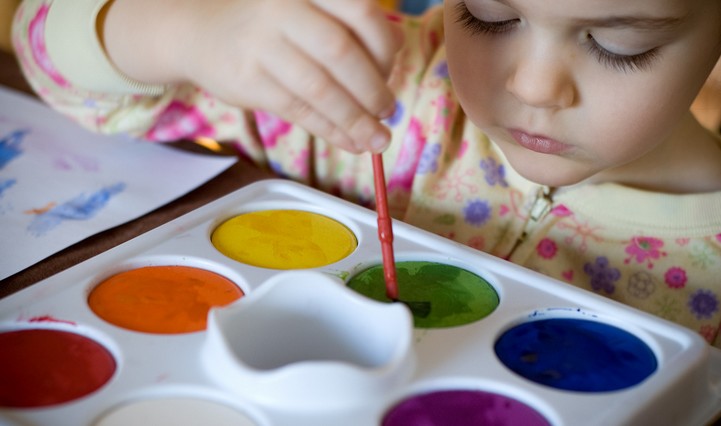Art Supports Children’s Development
Painting, coloring, sculpting, drawing, and other forms of creative art are an important part of the child care curriculum. Creating art supports young children’s development across several different domains. Using art tools helps children develop small muscle coordination and control. Children can practice thinking skills by experimenting with color, texture, and design. Art gives children an opportunity to express their ideas and feelings, relieves tension, and provides limits for self-discipline. Art allows children to achieve and expand their creativity.
Setting Up the Art Center
Because art can be such an important learning experience, it’s important for child care programs to include a well-designed art center. The specific set-up of the art center depends on the ages of the children in the group.
- An infant room probably will not have a permanent art center. Child care providers can begin introducing infants to a few art materials when the infants can sit up and begin controlling their hand movements. Art materials for infants should be brought out when needed, and put away when the activity is over. Art materials should be stored out of the infants’ reach when not in use.
- A toddler room may have an art center with some materials available to children throughout the day. A toddler art center might include fat crayons and paper that children can select and use independently (with adult supervision, of course). Messier materials, such as paint and glue, or materials that need more supervision, such as preschool scissors, should still be stored out of children’s reach and brought out only when needed.
- A preschool room often has a larger and more complex art center, such as the one pictured on this page. The preschool art center may contain many more materials, such as markers, glue sticks, preschool scissors, tissue paper, and chalk. In addition, many preschool art centers include an easel where painting, drawing, and other large-motor art activities can occur. Child care providers should rotate materials periodically to expand children’s creative process.
Setting and Enforcing Rules for the Art Center
To keep children safe and to encourage creativity, child care providers should set and enforce certain guidelines for preschool-age children using the art center. Some common rules include:
- Wearing smocks when using messy materials such as paint
- Painting or drawing only on the paper or object, not other surfaces
- Working only on your own creation, unless invited to share
- Putting away materials after completing project
- Washing hands before going to another activity
The Teacher’s Role in the Art Center
Child care providers should give instruction and assistance to children in the art center while still allowing room for the creativity of the child. Some of your main roles in facilitating children’s creative art include:
- Maintaining a supply of materials, and rotating them regularly to keep children interested
- Demonstrating the use of new tools and materials (e.g., how to manipulate clay or play dough, how to manipulate a paint roller)
- Assisting children in their creation only when asked
- Using open-ended questions to talk with children while they are creating
- Observing children’s skills, especially fine motor skills, and planning new art activities to support children’s development
- Putting children’s names on their creations if they request help
- Adding explanations or stories to creations if requested
- Instructing or assisting in the drying of creations
- Assisting children with clean-up
- Displaying some of the children’s art creations in the child care space
For more specific tips on setting up an art center, see Planning a Successful Art Center in Child Care.
For More Information
To learn more about art and other learning centers in the child care setting, take a look at the following eXtension Alliance for Better Child Care articles:
- Using Learning Centers in Child Care
- Making Creative Art Available to All Children in a Child Care Program
- Planning Creative Art Activities for Multi-Age Groups
Photo by Heather Katsoulis / CC BY http://creativecommons.org/licenses/by/2.0/

